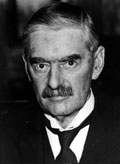 |
Arthur Neville Chamberlain
b. 18 Mar 1869, Edgbaston, Birmingham, Warwickshire
d. 9 Nov 1940, Heckfield House, near Odiham, Hampshire |
| Title: |
Prime Minister and First Lord of the Treasury |
| Term: |
28 May 1937 - 10 May 1940 |
| Chronology: |
28 May 1937, accepted the offer to hold the post of Prime Minister and First Lord of the Treasury, audience of the King, Buckingham Palace, London [1][2] |
|
28 May 1937, took the oath of office as First Lord of the Treasury before the King in Council, Buckingham Palace, London [3] |
|
10 May 1940, tendered resignation as Prime Minister and First Lord of the Treasury (accepted), audience of the King, Buckingham Palace, London [4] |
| Biography: |
| Son of Joseph Chamberlain, Lord Mayor of Birmingham (1873-1876) and MP, and half-brother of British politician Austen Chamberlain; attended a school near Southport, Merseyside; was educated at Rugby School, Warwickshire; studied commerce, metallurgy and engineering design at Mason Science College (from 1903 the University of Birmingham); supervised family business in the Bahamas (1891-1896); joined Elliott's Metal Company (1896), copper and brass producers; took over the entirely family-owned business of Hoskins and Sons, Bordesley (1897), manufacturers of metal cabin berths for ships; was elected to the Birmingham City Council (1911) as representative of All Saints Ward; served as Lord Mayor of Birmingham (1915-1916); was invited to join the Cabinet of David Lloyd-George as Director General of National Service (Dec 1916 - Aug 1917), responsible for coordinating conscription during World War I; returned to Parliament as Unionist/Conservative MP where he represented Birmingham, Ladywood (1918-1929), and Birmingham, Edgbaston (1929-1940); sworn in as a member of the U.K. Privy Council (2 Nov 1922); held the offices of Postmaster-General (2 Nov 1922 - 12 Mar 1923) and Paymaster-General (14 Feb 1923 - 15 Mar 1923); served as Minister of Health (7 Mar 1923 - 27 Aug 1923, 6 Nov 1924 - 7 Jun 1929, 25 Aug 1931 - 5 Nov 1931) and Chancellor of the Exchequer (11 Oct 1923 - 23 Jan 1924, 9 Nov 1931 - 28 May 1937) under Stanley Baldwin and Ramsay MacDonald; helped negotiate arrangements for a National Government in 1931; elected Chairman of the Conservative Party organization (23 Jun 1930 - 15 Apr 1931); when Baldwin retired, he was the obvious successor and accepted the post of Prime Minister and First Lord of the Treasury (28 May 1937 - 10 May 1940); elected Leader of the Conservative and Unionist Party (31 May 1937 - 4 Oct 1940); as head of government, he centered on foreign affairs; secured Parliamentary support for his policy of 'appeasement' of Nazi Germany; was one of the chief architects of the Munich Agreement (30 Sep 1938), granting almost all of Adolf Hitler's demands and leaving Czechoslovakia defenseless; promised British support for Poland should Germany intervene (1939); after the beginning of World War II, formed a War Cabinet; following the first serious British defeat in Norway campaign (1940), he almost lost the majority in Parliament; after much discussion he resigned as Prime Minister and First Lord of the Treasury (10 May 1940) to make way for Winston Churchill; briefly held the office of Lord President of the Council (12 May 1940 - 4 Oct 1940), but had to resign due to his failing health. |
| Biographical sources: "Neville Chamberlain", by David Dilks (Cambridge University Press, 1984), 2 vol.; "Neville Chamberlain: A Biography", by Robert C. Self (Aldershot: Ashgate, 2006); The Times, No. 48,770, Late London Edition, London Monday November 11 1940, p. 4 (obituary). |
| |
| [1] |
The Times, No. 47,697, Royal Edition, London Saturday May 29 1937, p. 17: "Court Circular - BUCKINGHAM PALACE, May 28 <...> The King subsequently received in audience the Right Hon. Neville Chamberlain, M.P., and offered to him the post of Prime Minister and First Lord of the Treasury. The Right Hon. Neville Chamberlain, M.P., accepted His Majesty's offer and kissed hands upon his appointment." |
| [2] |
Appointment as Lord Commissioner of the Treasury (prior to appointment as First Lord of the Treasury) by Letters Patent under the Great Seal is dated 12 Nov 1931, announced by the Crown Office 23 Nov 1931, and gazetted 24 Nov 1931 (The London Gazette, No. 33774, Tuesday, 24 November, 1931, p. 7577). |
| [3] |
The Times, No. 47,697, Royal Edition, London Saturday May 29 1937, p. 17: "Court Circular - BUCKINGHAM PALACE, May 28 <...> The King held a Council this afternoon at 5 o'clock. <...> The Right Hon. Neville Chamberlain, M.P., was sworn First Lord of the Treasury."; The London Gazette, No. 34403, Tuesday, 1 June, 1937, p. 3506. |
| [4] |
The Times, No. 48,613, Late London Edition, London Saturday May 11 1940, p. 9: "Court Circular - BUCKINGHAM PALACE, May 10 <...> The Right Hon. Neville Chamberlain, M.P., had an audience of The King this evening and tendered his resignation as Prime Minister and First Lord of the Treasury, which His Majesty was graciously pleased to accept." |

